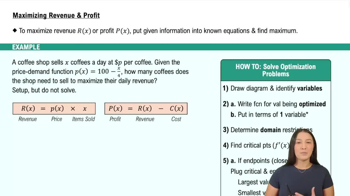Table of contents
- 0. Functions7h 52m
- Introduction to Functions16m
- Piecewise Functions10m
- Properties of Functions9m
- Common Functions1h 8m
- Transformations5m
- Combining Functions27m
- Exponent rules32m
- Exponential Functions28m
- Logarithmic Functions24m
- Properties of Logarithms34m
- Exponential & Logarithmic Equations35m
- Introduction to Trigonometric Functions38m
- Graphs of Trigonometric Functions44m
- Trigonometric Identities47m
- Inverse Trigonometric Functions48m
- 1. Limits and Continuity2h 2m
- 2. Intro to Derivatives1h 33m
- 3. Techniques of Differentiation3h 18m
- 4. Applications of Derivatives2h 38m
- 5. Graphical Applications of Derivatives6h 2m
- 6. Derivatives of Inverse, Exponential, & Logarithmic Functions2h 37m
- 7. Antiderivatives & Indefinite Integrals1h 26m
- 8. Definite Integrals4h 44m
- 9. Graphical Applications of Integrals2h 27m
- 10. Physics Applications of Integrals 2h 22m
5. Graphical Applications of Derivatives
Applied Optimization
Problem 4.R.35
Textbook Question
Optimal popcorn box A small popcorn box is created from a 12" x 12" sheet of paperboard by first cutting out four shaded rectangles, each of length x and width x/2 (see figure). The remaining paperboard is folded along the solid lines to form a box. What dimensions of the box maximize the volume of the box? <IMAGE>
 Verified step by step guidance
Verified step by step guidance1
First, understand the problem: We need to maximize the volume of a box formed by cutting and folding a 12" x 12" sheet of paperboard. The cuts are four rectangles, each with dimensions x by x/2.
Calculate the dimensions of the base of the box after the cuts. The original sheet is 12" x 12". After cutting out the rectangles, the length and width of the base will be reduced by 2x each, resulting in dimensions (12 - 2x) by (12 - x).
The height of the box will be x/2, as this is the width of the rectangles being cut out and folded up to form the sides of the box.
Write the volume function V(x) for the box. The volume V is given by the product of the base area and the height: V(x) = (12 - 2x)(12 - x)(x/2).
To find the value of x that maximizes the volume, take the derivative of V(x) with respect to x, set it equal to zero, and solve for x. This will give the critical points. Use the second derivative test or analyze the sign changes to determine which critical point gives the maximum volume.
 Verified video answer for a similar problem:
Verified video answer for a similar problem:This video solution was recommended by our tutors as helpful for the problem above
Video duration:
7mPlay a video:
Was this helpful?
Key Concepts
Here are the essential concepts you must grasp in order to answer the question correctly.
Volume of a Box
The volume of a rectangular box is calculated using the formula V = length × width × height. In this problem, the dimensions of the box are influenced by the cuts made from the paperboard, which will affect the final dimensions after folding. Understanding how to express the volume in terms of a single variable, based on the cuts made, is crucial for maximizing the volume.
Recommended video:

Example 5: Packaging Design
Optimization
Optimization in calculus involves finding the maximum or minimum values of a function. In this context, we need to determine the dimensions that maximize the volume of the box. This typically involves taking the derivative of the volume function, setting it to zero to find critical points, and using the second derivative test to confirm whether these points yield a maximum volume.
Recommended video:

Intro to Applied Optimization: Maximizing Area
Derivatives
Derivatives represent the rate of change of a function and are fundamental in finding local maxima and minima. In this problem, we will differentiate the volume function with respect to the variable x, which represents the dimensions of the cuts. Analyzing the derivative helps identify critical points where the volume could be maximized, guiding us to the optimal dimensions for the box.
Recommended video:

Derivatives

 1:13m
1:13mWatch next
Master Intro to Applied Optimization: Maximizing Area with a bite sized video explanation from Callie
Start learningRelated Videos
Related Practice







